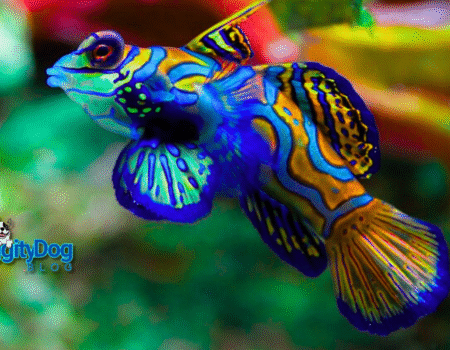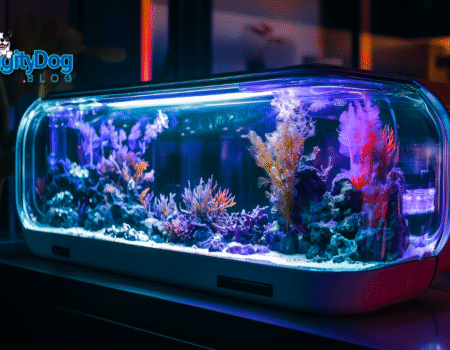Welcome to our guide on black and white clownfish, where we dive into the fascinating world of these unique marine aquarium fish. With their striking colors and captivating appearance, black and white clownfish are a popular choice for saltwater enthusiasts and hobbyists. In this article, we will explore the different variations, breeding techniques, and care tips for these exotic clownfish species.
Key Takeaways:
- Black and white clownfish, such as the Black Ice Clownfish, are bred through crossbreeding the black ocellaris and snowflake clownfish.
- They have a mostly black body with white stripes on their head, fins, and tail.
- Black Ice Clownfish are monogamous and spawn on flat surfaces, with the male fiercely defending the eggs until they hatch.
- These clownfish are omnivorous and can be fed high-quality pellets, frozen or live foods, and algae or seaweed sheets.
- They can be kept in a home aquarium of at least 76 liters (20 gallons) with other clownfish or peaceful community fish.
The Black Ice Clownfish: Appearance and Natural Habitat
The Black Ice Clownfish is a captivating marine species renowned for its distinctive black and white coloration. This stunning clownfish variant is the result of captive breeding, specifically through the crossbreeding of the black ocellaris and snowflake clownfish.
Featuring a mostly black body adorned with elegant white stripes on its head, fins, and tail, the Black Ice Clownfish mesmerizes marine enthusiasts with its contrasting beauty. Growing up to 10 centimeters (4 inches) in length, this resilient species can thrive for up to 10 years in a well-maintained aquarium environment.
While it may appear similar to its counterpart, the Snowflake Clownfish, the Black Ice Clownfish boasts a more prominent black coloration with a distinct absence of orange hues. This enchanting combination makes it a highly sought-after addition to any marine aquarium.
Unlike many clownfish species, the Black Ice Clownfish is exclusively found in captivity. Native to the Indian Ocean, specifically ranging from Darwin, Australia to Indonesia, this species thrives in coral reefs and rocky areas. It demonstrates a particular preference for water temperatures ranging from 24 to 28 degrees Celsius (75 to 82 degrees Fahrenheit).
| Characteristic | Description |
|---|---|
| Common Name | Black Ice Clownfish |
| Species | Amphiprion ocellaris and Amphiprion percula |
| Coloration | Mostly black body with white stripes on the head, fins, and tail |
| Length | Up to 10 centimeters (4 inches) |
| Lifespan | Up to 10 years in captivity |
| Preferred Habitat | Coral reefs and rocky areas in the Indian Ocean |
| Temperature Range | 24 to 28 degrees Celsius (75 to 82 degrees Fahrenheit) |
With its unique appearance and captivating allure, the Black Ice Clownfish continues to captivate the hearts of marine enthusiasts around the world. Whether in experienced hands or those of devoted hobbyists, this graceful creature brings elegance to any aquarium to which it calls home.
The Black Ice Clownfish: Behavior and Reproduction
The Black Ice Clownfish is a social and active species, often seen swimming near the surface of the water or hiding among coral structures. It forms symbiotic relationships with anemones in the wild, but in captivity, it can also bond with other clownfish or shrimp.
This species is monogamous and spawns on flat surfaces such as rocks or plants, with the male fiercely defending the eggs until they hatch after 8 to 10 days. The Black Ice Clownfish has a lifespan of up to 10 years in captivity.
During the mating season, the male and female Black Ice Clownfish perform an intricate courtship dance. The male will display vibrant colors and perform various movements to attract the female’s attention. Once they have paired, they will search for a suitable spawning site and meticulously clean it to ensure the eggs have a clean and safe environment to develop.
The male Black Ice Clownfish takes the primary responsibility of guarding the eggs, relentlessly chasing away potential threats from other fish or predators. He will fan the eggs with his pectoral fins to ensure proper oxygenation, as well as remove any debris or dead eggs from the clutch.
The Black Ice Clownfish has developed several intriguing adaptations to protect its eggs. It secretes a mucus layer around the eggs, acting as a defensive barrier against parasites and bacteria. Additionally, it has been observed that the male clownfish will use its pelvic fins to agitate the eggs, preventing them from becoming prey to opportunistic predators.
| Behavior and Reproduction | Description |
|---|---|
| Social Nature | The Black Ice Clownfish is a social species that forms symbiotic relationships with anemones in the wild. |
| Monogamous | This species is monogamous, with the male and female forming a lifelong bond. |
| Spawning Behavior | The Black Ice Clownfish spawns on flat surfaces such as rocks or plants, with the male fiercely guarding the eggs. |
| Egg Defense | To protect the eggs, the male Black Ice Clownfish secretes a mucus layer and agitates the eggs to deter predators. |
| Lifespan | The Black Ice Clownfish has a lifespan of up to 10 years in captivity. |
Overall, the Black Ice Clownfish exhibits fascinating behavior and reproduction strategies. Its social nature, monogamy, and unique spawning behavior make it a captivating species to observe in both the wild and captivity.
The Black Ice Clownfish: Diet and Feeding
As an omnivorous species, the Black Ice Clownfish has a diverse diet that includes both plant and animal matter. In the wild, they consume a variety of foods to meet their nutritional needs. When kept in captivity, it is important to provide them with a well-rounded diet to ensure their health and well-being.
High-Quality Pellets: One of the main components of a Black Ice Clownfish’s diet should be high-quality pellets specifically formulated for marine fish. These pellets are designed to provide a balanced mix of proteins, vitamins, and minerals to support their overall health.
Frozen or Live Foods: Supplementing their diet with frozen or live foods is crucial to mimic the variety they would consume in their natural habitat. Brine shrimp and mysis shrimp are popular choices, as they provide essential proteins and fats for optimal growth and development.
Algae or Seaweed Sheets: Black Ice Clownfish also benefit from the inclusion of algae or seaweed sheets in their diet. These green additions provide necessary fiber, trace elements, and carotenoids, which contribute to their vibrant coloration.
It’s important to note that the diet of a Black Ice Clownfish should be varied and balanced. This can be achieved by offering a combination of high-quality pellets, frozen or live foods, and algae or seaweed sheets. Monitoring their feeding habits and adjusting the diet as needed will help ensure their long-term health and vitality.
The Importance of a Balanced Diet
Providing a balanced diet for the Black Ice Clownfish is essential for their overall well-being. A varied diet offers a range of nutrients that support their immune system, growth, and reproductive health. By replicating the diversity of their natural diet, we can help promote their longevity and enhance their vibrant coloration.
| Food Type | Benefits |
|---|---|
| High-Quality Pellets | Provides essential proteins, vitamins, and minerals |
| Frozen or Live Foods | Offers additional proteins and fats for growth and development |
| Algae or Seaweed Sheets | Supplies fiber, trace elements, and carotenoids for coloration |
By incorporating these different food sources into their diet, we can help ensure that the Black Ice Clownfish thrives in a home aquarium environment.
The Black Ice Clownfish: Keeping in a Home Aquarium
When it comes to housing the captivating Black Ice Clownfish in a home aquarium, there are a few key factors to consider to ensure their well-being and happiness.
Tank Size and Setup
The Black Ice Clownfish should be provided with a home aquarium of at least 76 liters (20 gallons). This tank size offers enough space for the clownfish to swim and explore, promoting their physical and mental wellbeing. It is essential to create an environment that mimics their natural habitat. Providing ample hiding places with rocks or live plants enables the clownfish to establish territories and feel secure.
Water Temperature and pH
Maintaining the ideal water temperature and pH level is crucial for the health of the Black Ice Clownfish. The recommended water temperature range for this species is between 24 to 28 degrees Celsius (75 to 82 degrees Fahrenheit). It is also important to keep the pH level between 7.8 and 8.4, as these levels replicate their natural marine environment.
Compatibility with Other Fish
The Black Ice Clownfish is generally peaceful and can coexist with other clownfish or peaceful community fish. When choosing tankmates, it is important to consider their compatibility in terms of temperament and size. Avoid pairing them with aggressive or territorial species that may threaten or harm the clownfish.
An Engaging and Visually Appealing Black Ice Clownfish Table
| Aspect | Requirements |
|---|---|
| Tank Size | At least 76 liters (20 gallons) |
| Water Temperature | 24 to 28 degrees Celsius (75 to 82 degrees Fahrenheit) |
| pH Level | 7.8 to 8.4 |
| Compatibility | Clownfish or peaceful community fish |
By following these guidelines, you can create an ideal home for the Black Ice Clownfish in your aquarium. Providing the right tank size, maintaining the appropriate water temperature and pH level, and selecting compatible tankmates will contribute to the overall well-being and happiness of these mesmerizing marine creatures.
Common Types of Clownfish: The False Clownfish
The common types of clownfish, also known as false clownfish or ocellaris clownfish, are indigenous to the waters of the Western Pacific and the Eastern Indian Oceans. These peaceful fish have vividly orange bodies with three white stripes running vertically along their tail, face, and middle. They are omnivorous and prefer a diet of pellets, flakes, and frozen and live meaty foods. The common types of clownfish are easy to care for and make a great addition to a reef tank.
When it comes to the fascinating world of clownfish, the false clownfish, also known as the ocellaris clownfish, is one of the most popular and recognizable species. With its vibrant orange body adorned with three distinct white stripes, this fish is a delightful sight to behold. Indigenous to the Western Pacific and Eastern Indian Oceans, these peaceful clownfish species can be found in the tropical waters of Australia, the Philippines, and other nearby regions.
A true icon of the ocean, false clownfish are omnivorous creatures, meaning they consume both plant matter and small crustaceans. They have a varied diet that includes high-quality pellets, flakes, live brine shrimp, and frozen foods. This ensures they receive all the necessary nutrients to thrive in both the wild and home aquariums.
False clownfish are known for their adaptability and ease of care, making them excellent choices for beginner aquarists. They are also quite hardy and can tolerate a wide range of water parameters, provided that the basic requirements of temperature, salinity, and pH are met.
These clownfish are typically found in and around coral reefs, where they form symbiotic partnerships with sea anemones. The clownfish seek protection within the anemone’s stinging tentacles, while the anemone benefits from the clownfish’s presence by attracting prey and receiving food particles from their meals.
The false clownfish is a captivating creature that brings vibrant colors and playful charm to any marine aquarium. With their stunning orange bodies and distinct white stripes, they are a true delight to observe. Whether you’re an experienced aquarist or new to the hobby, adding false clownfish to your reef tank is sure to enhance its beauty and bring joy to your underwater world.
A Variety of Clownfish Species: Unique Traits and Care
Different clownfish species have unique traits and care requirements. While some species are known for their peaceful nature, others can exhibit territorial and aggressive behavior, especially under certain circumstances. To provide the best care for clownfish in a home aquarium, it is important to understand the specific needs of each species and create an environment that closely mimics their natural habitat.
Territorial Behavior and Aggression
Certain clownfish species are naturally territorial and can display aggressive behavior, particularly when defending their territories or eggs. This behavior is more commonly observed in species such as the maroon clownfish (Premnas biaculeatus). These territorial tendencies can manifest as aggression towards other fish, especially if they intrude on their space. It is crucial to provide adequate space and hiding places in the aquarium to minimize potential conflicts between clownfish and other tankmates.
Natural Habitat and Tank Size
The natural habitat of clownfish species varies, with different species found in different regions of the world’s oceans. For example, the maroon clownfish is native to the Western Pacific, while the ocellaris clownfish (Amphiprion ocellaris) is found in the Eastern Indian and Western Pacific Oceans. To ensure the well-being of clownfish, it is essential to research and provide an appropriate tank size that allows them ample space to swim and establish territories. Below is a table listing the tank size recommendations for selected clownfish species:
| Clownfish Species | Minimum Tank Size |
|---|---|
| Maroon Clownfish | 75 gallons |
| Ocellaris Clownfish | 20 gallons |
| Percula Clownfish | 20 gallons |
Diet and Feeding
The diet of clownfish species can vary, but most clownfish are considered omnivorous, feeding on a combination of meaty foods and plant matter. In the wild, clownfish consume a wide range of small invertebrates, algae, and plankton. To ensure a well-rounded diet in captivity, it is recommended to feed high-quality commercial pellets or flakes specifically formulated for marine fish, supplemented with occasional feedings of frozen or live foods such as brine shrimp, mysis shrimp, and copepods. Additionally, providing algae or seaweed sheets can fulfill their need for plant matter. It is important to feed clownfish multiple times a day, in small portions, to mimic their natural feeding behavior.
A Variety of Clownfish Species: Allard Clownfish
The Allard clownfish is a captivating species native to the western Indian Ocean. It is widely admired for its vibrant coloration and unique markings. With a brownish body adorned with orange highlights on the belly and fins, the Allard clownfish is truly a sight to behold. It features two white bars with black edging that encircle its entire body, adding to its striking appearance.
One of the standout characteristics of the Allard clownfish is its adaptability. This species can thrive in various conditions, making it a versatile choice for aquarium enthusiasts. Whether you are an experienced aquarist or a beginner, the Allard clownfish can easily acclimate to your tank’s environment.
In terms of temperament, the Allard clownfish is known for its peaceful nature. It coexists harmoniously with other fish in a community tank, making it an excellent addition to any marine aquarium setup. Its calm demeanor adds a tranquil element to your underwater ecosystem.
Like other clownfish species, the Allard clownfish follows an omnivorous diet. It happily consumes a variety of foods, including high-quality pellets, flakes, frozen or live foods, and even algae or seaweed sheets. Providing a well-balanced and nutritious diet ensures the overall health and vibrancy of this beautiful species.
If you’re looking for a captivating and adaptable clownfish species with vibrant coloration and a peaceful temperament, the Allard clownfish should be at the top of your list. Adding these stunning creatures to your aquarium will undoubtedly enhance the beauty and diversity of your underwater world.
| Species | Origin | Coloration | Adaptability | Temperament |
|---|---|---|---|---|
| Allard Clownfish | Western Indian Ocean | Brownish body with orange highlights, white bars with black edging | Highly adaptable to various tank conditions | Peaceful |
A Variety of Clownfish Species: Cinnamon Clownfish
The cinnamon clownfish is native to the western Pacific and is a captivating species known for its fiery visage and unique coloration. With a vibrant mixture of dark red and orange tones, this clownfish species adds a bold and striking presence to any aquarium.
Compared to the common clownfish, the cinnamon clownfish has a more compact and rounder body shape. This distinctive physical characteristic sets it apart and adds to its allure.
The cinnamon clownfish is highly adaptable and hardy, making it a suitable choice for beginner and experienced aquarists alike. Its adaptability allows it to thrive in various tank conditions, making it more forgiving in terms of water parameters and maintenance requirements.
However, it is essential to note that the cinnamon clownfish can exhibit aggression, especially when kept with fish of the same species or similar coloring. Careful consideration should be taken when adding this species to a community tank to ensure compatibility and minimize aggressive behavior.
Overall, the cinnamon clownfish is a stunning addition to any marine aquarium. Its fiery visage and unique coloration make it a standout species that will captivate the attention of anyone admiring the underwater world.
A Variety of Clownfish Species: Clarkii Clownfish
Lorem ipsum dolor sit amet, consectetur adipiscing elit. Phasellus luctus arcu et tellus pulvinar, vel accumsan nisi placerat. Vivamus id condimentum urna. Nunc ut malesuada felis, vel euismod neque. Fusce et eros condimentum, scelerisque neque id, mollis neque. Interdum et malesuada fames ac ante ipsum primis in faucibus. Etiam auctor mauris a mauris fringilla mollis. Sed in dolor id ligula euismod malesuada.
Clarkii clownfish, also known as the Sebae clownfish, are native to the waters of the Western Pacific and Indian Oceans. This species is part of the Clarkii complex, which comprises several different species, each with its own unique variation in coloration. The Clarkii clownfish is known for its vibrant hues, ranging from bright oranges to deep reds and even blues. The distinct coloration of each individual clownfish adds to the beauty and diversity of this species.
When it comes to behavior, Clarkii clownfish are generally peaceful when provided with ample space and a reef structure that includes caves and hiding places. However, they can become territorial and may exhibit aggression towards similar-looking tankmates, especially when defending their territory. It is important to consider the compatibility of tankmates when keeping Clarkii clownfish.
As for their preferences in lighting, Clarkii clownfish tend to thrive in slightly less light compared to other clownfish species. They are often found in deeper, darker waters in their natural habitat. This preference for subdued lighting is an important consideration when setting up an aquarium for Clarkii clownfish.
When it comes to diet, Clarkii clownfish are omnivorous and have a diverse range of food preferences. They will readily accept a variety of high-quality pellets, flakes, and frozen or live foods. It is essential to provide a balanced diet that includes both protein-rich and plant-based foods to ensure the health and vitality of Clarkii clownfish.
Want to see the beautiful colors of the Clarkii clownfish? Check out the image below:
Curious about the different species within the Clarkii complex? Take a look at the table below:
| Species | Coloration |
|---|---|
| Amphiprion clarkii | Orange body with white stripes |
| Amphiprion clarkii “Darwin” | Black body with white stripes |
| Amphiprion clarkii “Sumatra” | Reddish-brown body with white stripes |
As seen in the table, each species within the Clarkii complex showcases its own stunning variation in coloration. Whether you prefer the classic orange coloration or the striking black and white combination, there is a Clarkii clownfish species that will capture your heart.
A Variety of Clownfish Species: Maroon Clownfish
The maroon clownfish, native to the Western Pacific, is a captivating species known for its striking deep red body color. Some maroon clownfish specimens also exhibit a beautiful golden hue, which classifies them as gold-stripe maroon clownfish. These mesmerizing creatures are among the largest of the clownfish species.
However, it is important to note that maroon clownfish can display territorial and aggressive behavior, especially in the case of larger females. To ensure their well-being and minimize any potential conflicts with tankmates, it is crucial to provide them with a large tank that offers ample space for swimming and multiple hiding places.
Creating a suitable aquarium environment for maroon clownfish involves careful consideration of their territoriality and potential for aggression. By setting up a spacious tank with plenty of hiding spots, you can help create a harmonious living space for these magnificent creatures, allowing them to thrive and showcasing their natural behaviors.
FAQ
What is the Black Ice Clownfish?
The Black Ice Clownfish is a striking and popular marine aquarium fish known for its unique black and white coloration. It is a variation of the common clownfish and is bred in captivity by crossbreeding the black ocellaris and snowflake clownfish.
What does the Black Ice Clownfish look like?
The Black Ice Clownfish has a mostly black body with white stripes on its head, fins, and tail. It can reach up to 10 centimeters (4 inches) in length.
How long does the Black Ice Clownfish live?
The Black Ice Clownfish has a lifespan of up to 10 years in captivity.
Is the Black Ice Clownfish a social species?
Yes, the Black Ice Clownfish is a social and active species often seen swimming near the surface of the water or hiding among coral structures.
What does the Black Ice Clownfish eat?
The Black Ice Clownfish is an omnivorous species that consumes high-quality pellets, frozen or live foods, and algae or seaweed sheets.
Can the Black Ice Clownfish be kept with other fish?
Yes, the Black Ice Clownfish can be kept in a home aquarium with other clownfish or peaceful community fish.
Are there different types of clownfish?
Yes, there are different types of clownfish with unique traits and care requirements.
What is the most common type of clownfish?
The most common type of clownfish is the false clownfish, also known as the ocellaris clownfish. It is indigenous to the Western Pacific and Eastern Indian Oceans.
What is the natural habitat of the Allard clownfish?
The Allard clownfish is native to the western Indian Ocean and inhabits coral reefs and rocky areas.
How does the cinnamon clownfish behave?
The cinnamon clownfish is adaptable and hardy but can become aggressive, especially when mixed with fish of the same species or similar coloring.
What is unique about the Clarkii clownfish?
The Clarkii clownfish is from the waters of the Western Pacific and Indian Oceans. It has several different species within its complex, each with its own variation in coloration.
What should be considered when keeping a maroon clownfish?
Keeping a maroon clownfish requires a large tank with ample room for swimming and hiding places to decrease the chances of aggression towards tankmates.










No Comment! Be the first one.